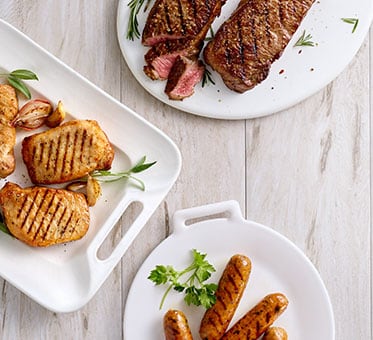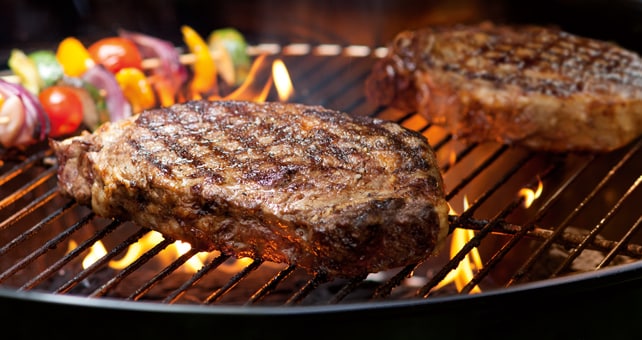Prepare the perfect steak.
- Figure out how much you'll need. Average 9–14 ounces per person, depending on thickness and whether or not your steak includes a bone. Your Publix Meat associate can help you determine exactly how much you'll need.
- Choose seasonings. Simple seasonings like olive oil, salt, and pepper allow the natural flavor to shine through. Dry rubs, applied 15-30 minutes before grilling, can spice things up a bit. Marinades, added 15 minutes to 2 hours in advance, add juicy flavor throughout the steak.
- Bring the steak to room temperature (about 20 minutes on the counter) just before cooking. This way, the steak will cook more quickly, preserving its juices.
- Top hot steaks with a bit of blue cheese if desired, for extra flavor.
Go for the grill.
We recommend an outdoor gas, charcoal, or wood grill—and these tips.
- Clean the grill grate with a brass or steel brush after each use.
- Don't oil the grate.
- Preheat the grill for at least 10 minutes.
- Check that the grilling surface is heated to 450-500°F with the lid closed.
With charcoal or hardwoods:
- Keep the vents open while the lid is closed.
- Prepare the charcoal for grilling. When coals are ash-covered, spread them into a single layer.
- Keep the grate 3-6 inches from the coals.
Other grilling tips:
- Use tongs or a spatula so as not to pierce the steak and lose the juices that keep it moist and tender.
- Get gorgeous grill marks and even cooking. Pick a corner of the steak and point it to 10:00. After 1/4 of the cooking time passes, rotate that corner to 2:00. Repeat on the other side of the steak.
- Don't press the steak. You'll force moisture out.
- Start hot, then cool a bit. Twenty minutes of direct heat followed by a finish on indirect heat results in a nice crust and tender center.
- Prepare for flare-ups. Keep a spray bottle of water and a sheet of foil handy. In the case of a flare-up, mist water on the flames and prevent dripping fat by sliding the foil under your steak.
Timing is everything.
Steakhouse Cuts® take longer to cook than thinner steaks. Look up your cut and your doneness preferences in the charts below, and have a thermometer nearby for testing.
Don't have a preference? May we suggest medium rare?
Check the temperature with an instant-read thermometer after 3/4 of the recommended cooking time, and then as needed, until it reaches the desired temperature. Remember—always remove the meat from the grill at 5°F below your target temperature. It will continue to cook off the grill for a few minutes.
Let steaks rest for 5 minutes per inch of thickness before piercing or slicing. You'll preserve their juices and moisture.
Cooking times and temperatures.
The basic internal temperatures to target when cooking steak are:
- Medium-Rare: MR 145°F
- Medium: M 160°F
- Medium-Well: MW 165°F
Use this chart to determine the preferred cooking times for each cut of steak. Remember that grills vary and cook times may be slightly different. To cook a thicker or thinner cut, simply add or subtract approximately 2 minutes of cook time for every quarter-inch increase or decrease in thickness.
| Steak Cut | Ideal Thickness | Approximate Cooking Time in Minutes | ||
|---|---|---|---|---|
| T-Bone and Porterhouse | 1.5" | MR 16-18 | M 19-21 | MW 22-24 |
| Ribeye Steak | 1.5" | MR 8-10 | M 11-13 | MW 14-16 |
| Strip Steak | 1.5" | MR 10-12 | M 13-15 | MW 16-18 |
| Filet Mignon (Tenderloin) | 1.75" | MR 15-16 | M 18-19 | MW 21-22 |
| Top Sirloin and Sirloin Fillet | 1.5" | MR 16-18 | M 18-19 | MW 20-22 |
The cuts.
T-Bone and Porterhouse Steak
Crowd-pleasing cuts, these steaks are big on flavor. Both cuts include a T-shaped bone in their center. Meat on the smaller side is the tenderloin, which is tender and contains less fat. Meat on the larger side is the strip, with more fat and flavor. To prepare, position the leaner side away from the high heat on the grill, and cook these steaks at lower temperatures.
Ribeye Steak
With great marbling, ribeyes cook up tender, juicy, and rich with flavor. Prefer a well-done steak? Go with a ribeye. The marbling maintains moistness even with more cooking. Juicy ribeyes do tend to cause grill flare-ups, so be prepared.
Strip Steak
The preferred steak of many true steak lovers, strip steak is a high-quality cut from the short loin, the most tender section of beef. It's also a more affordable alternative to filet mignon. Go for a thicker cut, as it produces a great crust on the grill.
Filet Mignon
The most tender cut of meat, filet mignon has a melt-in-your-mouth texture that makes it the perfect choice if you like a nice, rare steak. You'll pay a high price for filet mignon at restaurants, but you can treat yourself to one at home for much less.
Top Sirloin and Sirloin Fillet
The top sirloin comes from the tender, juicy center of the sirloin. And the fillet is the best part of the top sirloin. They're both great for grilling. Just make sure you take them off the grill when they reach 5°F below your target temperature. These steaks tend to keep cooking, and you don't want them to become dry.
Put antibiotics and added hormones* on the back burner.

Our GreenWise meats are raised here in the United States with no antibiotics or added hormones,* and fed a 100% vegetarian diet. This wide variety of chicken, beef, pork, lamb, and turkey grills up succulent, tender, juicy and ready to complement any of these recipes.
*Federal regulations prohibit the use of added hormones in poultry.

 You are about to leave publix.com and enter the Instacart site that they operate and control. Publix’s delivery and curbside pickup item prices are higher than item prices in physical store locations. Prices are based on data collected in store and are subject to delays and errors. Fees, tips & taxes may apply. Subject to terms & availability. Publix Liquors orders cannot be combined with grocery delivery. Drink Responsibly. Be 21. For prescription delivery, log in to your pharmacy account by using the Publix Pharmacy app or visiting
You are about to leave publix.com and enter the Instacart site that they operate and control. Publix’s delivery and curbside pickup item prices are higher than item prices in physical store locations. Prices are based on data collected in store and are subject to delays and errors. Fees, tips & taxes may apply. Subject to terms & availability. Publix Liquors orders cannot be combined with grocery delivery. Drink Responsibly. Be 21. For prescription delivery, log in to your pharmacy account by using the Publix Pharmacy app or visiting 